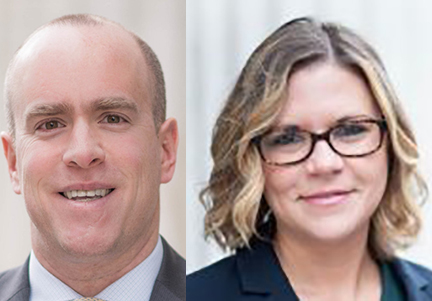The number of COVID-19 diagnostic tests administered continues to climb throughout the United States. However, concerns remain about the accuracy of these tests.1 More than 150 tests were initially authorized under the FDA’s EUA notification pathway but have now been removed from the market. And, there have been high profile circumstances of improper test results, such as in late August 2020 when 77 NFL players received positive test results for COVID-19, when all 77 were actually negative for COVID-19.
In part one of this series, we looked at likely claims and defenses in product liability lawsuits involving COVID-19 tests. In part two of this series we looked at lessons from past lawsuits against diagnostic equipment manufacturers. In this part of the series, we examine the liability risks and defenses of healthcare providers and laboratories for COVID-19 tests. First, this article reviews the application of the PREP Act, which gives legal immunity to providers and laboratories under certain circumstances. Then, we review key defenses available to each element of a lawsuit against providers and laboratories.
PREP Act Immunity for Healthcare Providers and Laboratories
Any review of the liability exposure of healthcare providers and laboratories must begin with an overview of the PREP Act. The PREP Act provides nearly blanket immunity under certain circumstances for manufacturers, distributors and administrators of certain drugs, medical devices and biologics meant to counteract an epidemic or pandemic.2 This immunity extends to medical devices that have been authorized by the FDA under its Emergency Use Authorization (EUA) authority.3
Specifically, the PREP Act applies to products that are, among other things, “authorized for emergency use in accordance with” the EUA statutes.4 As the FDA has authorized most (but certainly not all) COVID-19 diagnostic tests under its EUA authority, COVID-19 authorized diagnostic tests fall within the ambit of PREP Act immunity.
Thus, in analyzing the applicability of the PREP Act to healthcare providers and laboratories, three obvious questions arise: (i) Are providers and laboratories protected by the PREP Act for authorized diagnostic tests, (ii) what exceptions to immunity are there for authorized tests, and (iii) which tests are authorized? Each question is addressed in turn.
First, in addition to protecting a manufacturer and a distributor of COVID-19 diagnostic tests, the PREP Act protects “a licensed health professional or other individual who is authorized to prescribe, administer, or dispense” an authorized COVID-19 diagnostic test.5 This definition likely includes not only those licensed to provide COVID-19 diagnostic tests under state law, but even applies to pharmacists not licensed under state law to do so.6
Second, as discussed in more depth in part one of this series, the PREP Act itself only provides one exception to its immunity, which is, for willful misconduct.4 Proving willful misconduct is a high hurdle. As there is scant case law on the PREP Act, creative plaintiffs may try to circumvent the PREP Act in any number of ways, for example, such as arguing there was willful and wanton conduct, the tests were not administered within the scope of the authorization, or the revocation of the EUA somehow removes PREP Act immunity. Regardless, the PREP Act still creates a formidable barrier to suit, and these arguments will likely be an uphill battle for plaintiffs.
Third, and perhaps the trickiest question, is which tests are authorized under the FDA’s EUA authority for PREP Act purposes. On one end of the spectrum, certainly tests that have been specifically authorized by the FDA should squarely fall within the purview of the PREP Act. On the other end of the spectrum, the FDA’s current position is that laboratory developed tests that do not go through the authorization process are not covered by the PREP Act. The unclear middle ground includes tests following FDA’s notification pathway that do not get specific authorization and tests that only fall under an umbrella authorization. These are areas that are unfortunately ripe for litigation on the scope of the PREP Act.
Non-PREP Act Defenses
Assuming the provider or laboratory is not protected by the PREP Act, the next question is what are the other liability defenses for the provider or laboratory? In the case of a laboratory developed test, in the majority of jurisdictions the laboratory would be treated in the same manner as a medical device company for the test kit, and would face product liability claims (which was the subject of part one and part two of this series). However, assuming the laboratory is simply running another company’s test, its liability risk is more likely to fall into the professional negligence category for alleged errors.7
As a general matter, in order for a plaintiff to prove his or her case, he must show that (i) the provider or laboratory had a legal duty to protect the plaintiff using the skill, prudence, and diligence as other members of their profession commonly exercise, (ii) the provider or laboratory breached that duty, (iii) and this breach caused plaintiff to be injured.8 Defenses to each element are addressed in turn.
Duty and Standard of Care
As a general matter, a provider or laboratory is only liable if it has a legal duty and its actions fall below the standard of care. Most jurisdictions find that providers and laboratories owe a duty of care to their direct patients.9 A more interesting question arises if a patient receives a false negative result, infects another person, and that person sues the provider for the false negative. Setting aside the complex causation issues, courts disagree on whether a provider owes a duty to non-patients.10 As such, depending upon the jurisdiction, a provider or laboratory may have a defense to a lawsuit by a non-patient based upon a lack of duty.
Breach of the Standard of Care
The next issue is whether the provider or laboratory fell below the standard of care. Generally, whether an act or omission breaches the standard of care is determined on a case-by-case basis, in light of the specific factual circumstances.11 In some cases, litigants refer to government or professional association regulations and guidelines, facility policies and protocols, or FDA warnings to help define, but not necessarily establish, the standard of care in particular situations.12,13,14 In the context of COVID-19 testing, plaintiffs are likely to look to these same sources, in addition to any information provided by the test manufacturer. To the extent guidelines and recommendations vary, this variety may unfortunately help plaintiffs attempt to pick and choose a more favorable standard to them. At the same time, providers and laboratories can argue that there is no clearly defined standard of care, and that they acted reasonably by exercising their own judgment or following a particular protocol or guideline.15
Standard of care in this context could also be defined by analogy to related areas. For example, healthcare providers are trained that they must obtain an adequate sample for specimen testing. With respect to COVID-19, a patient could argue that failing to insert the swab sufficiently deep or removing the swab too quickly rendered the test results less reliable. Similarly, both providers and laboratory technicians must follow anti-contamination protocols to ensure the integrity of samples. While COVID-19 testing equipment is unique, general practices to avoid contamination are not. Another potential source of liability is the failure to warn. Providers are well versed on the obligation to inform patients of risks, but warning patients becomes more challenging when testing accuracy and spread risks remain somewhat uncertain.
With respect to provider liability, most if not all jurisdictions require expert testimony to establish a breach of the standard of care.16 Expert testimony could prove challenging for both plaintiffs and defendants as testing practices are inconsistent, even within organizations and facilities. Additionally, standards have already evolved significantly and are likely to continue to do so as more data becomes available. Pinpointing standard of care at a particular point in time could be difficult and (although it should not) it may potentially result in providers being held to a higher standard of care. On the other hand, inconsistency and rapidly evolving standards could advantage providers to the extent courts and juries are unwilling to hold providers liable for actions that were taken at a time when the appropriate course remained uncertain.
Causation and Damages
Setting aside the PREP Act, one of the largest issues in any lawsuit against a provider or laboratory is how the patient proves that the provider or laboratory’s false result caused an injury. At the outset, the patient either had COVID-19 or not, regardless of the tests result. And, under current guidance from the CDC, an exposed person should quarantine regardless of whether their COVID-19 test results are positive or negative, which should lessen the effect of a false negative result causing more spread. In most cases, it would also be quite difficult to prove that a false negative caused a spread. Nevertheless, one can certainly imagine claims that a false result caused a person to take actions or not take actions that caused damages to them or others.
A big question in COVID-19 test litigation is what damages/injuries a plaintiff could prove. In false negative cases, did the patient really receive less care than they would have otherwise? And for asymptomatic individuals, did they themselves suffer any damage at all from a false negative result? Nevertheless, it is not hard to imagine lawsuits alleging more dire results—for example, a false negative caused a delay in care, which caused a more serious injury, or a false negative resulted in further infections.
In a false positive case, most cases would involve at most only temporary monetary losses as someone quarantined unnecessarily. Moreover, in many jurisdictions simple fear and apprehension from a false positive result is not compensable.17 Nevertheless, one can imagine more pernicious and creative lawsuits, for example, claiming a false positive caused a person not to seek medical care for more immediately dire situations such as a stroke or heart attack.
To the extent plaintiffs are able to establish damages, providers and laboratories can still assert the common law and statutory affirmative defenses available in their jurisdiction. In addition to statutory caps on tort damages, there may be several opportunities to limit potential exposure.18 For example, a patient who delays treatment due to a false negative has failed to mitigate damages and may be comparatively at fault.19 Similarly, patients who reject provider instructions to remain quarantined while symptomatic regardless of test results have failed to follow medical advice.19 Providers and laboratories may also be able to identify intervening or superseding causes for the alleged injuries, reducing or eliminating liability.20
Conclusion
It is likely that some providers and laboratories will face lawsuits based upon false positive or false negative COVID-19 test results. However, these providers and laboratories have a host of defenses to these lawsuits.
The authors wish to acknowledge Alexis Sauer-Budge, Ph.D. and Christie Bergerson, Ph.D. for their technical input on several of the issues in this article.
References
- Janko van Beek, et al., From more testing to smart testing: data-guided SARS-CV-2 testing choices, Preprint at medRxiv.
- 42 U.S.C. § 247d-6d and 6e.
- 42 U.S.C. § 247d-6d(i)(1)(C).
- 42 U.S.C. § 247d-6d(i)(1)(C) (emphasis added).
- 42 U.S.C. § 247d-6d(i)(8).
- Advisory Opinion 20-2 on the Public Readiness and Emergency Preparedness Act (May 19, 2020).
- See 19 A.L.R.6th 793, § 2 (2006 & 2020 Supp.)
- 19 A.L.R.6th 793, § 2 (2006 & 2020 Supp.); 3 Modern Tort Law: Liability and Litigation § 24:1 (2d ed.).
- See 61 Am. Jur. 2d Physicians, Surgeons, Etc. § 229 (2020).
- Compare Lemon v. Stewart, 111 Md. App. 511, 682 A.2d 1177 (1996) (failure to warn patient he had AIDS did not create a duty to warn family members who nursed him) with Estate of Amos v. Vanderbilt University, 62 S.W.3d 133 (Tenn. 2001) (hospital owed duty of care to former patient and to the general public to warn former patient of her possible exposure to human immunodeficiency virus).
- See 61 Am. Jur. 2d Physicians, Surgeons, Etc. § 285 (2020).
- See, e.g., Distad v. Cubin, 633 P.2d 167, 176 (Wyo. 1981); Matthews v. Aganad, 914 N.E.2d 1233, 1240 (Ill. App. 2009).
- See, e.g., McCombs v. Children’s Hospital of Dallas, 1 S.W.3d 256, 259 (Tex. App. 1999).
- 82 A.L.R.4th 166 (1990).
- See, e.g., Shectman v. Bransfield, 959 A.2d 278, 282 (N.J. App. 2008).
- 81 A.L.R.2d 597 (1962).
- Compare Heiner v. Moretuzzo, 1995-Ohio-65, 73 Ohio St. 3d 80, 652 N.E.2d 664 (patient has no cause of action for false positive test result of HIV as she faced non actual physical peril); with Bramer v. Dotson, 190 W. Va. 200, 201–02, 437 S.E.2d 773, 774–75 (1993) (patients claims against a laboratory and clinic could proceed for false positive test result of HIV due to his emotional damages).
- See, e.g., C.R.S. § 13-64-302.
- 84 A.L.R.5th 619 (2000).
- See Hain v. Jamison, 68 N.E.3d 1233 (N.Y. App. 2016).







